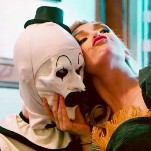A Historical Romance Writer Explains the Sex Appeal of Men in Wigs
In DepthYou know who doesn’t get enough love? Gentlemen in wigs.
While at the RT Booklovers Convention, I got a chance to chat with historical romance writer Elizabeth Hoyt. Her books balance sexiness and angst, a combination that’s right up my alley.
But what’s really interesting about Hoyt’s work is that she doesn’t stick to the time periods that are so popular in the historical romance subgenre—i.e., the Regency and early Victorian eras. (You can probably thank Charlotte Bronte and Jane Austen for that.) Her previous series, the four-part Legend of the Four Soldiers, was set in the 1760 and followed veterans of the French and Indian War. She just published Darling Rogue, her eighth installment in the Maiden Lane series, which takes place in 1730s. She uses the time’s obsession with gin to spin a tale of, basically, eighteenth-century Batman. Even during the everything-goes 1980s, when there were more pirates and Western adventurers and medieval knights, those decades weren’t common settings. At least one of her dudes wears a wig. Dudes never wear wigs in historical romance!
So I took a few moments to chat with her about why she picked these time periods, how art museums influence her writing process and lifelong impact of the original Poldark on her taste. A trimmed-down version of our conversation:
One of the things I really like about your books is that there are a couple of time periods that are really popular in romance. Victorian, Regency—
That’s about it, really. And even the Victorians, man, it has to be early Victorian, like Lisa Kleypas.
But you do the 1730s and your previous series was set in the 1760s. And I really like that because I feel like the 1700s don’t get enough love!
Oh I know, guys in high heels and wigs. Why not? And then in the early part they were wearing coats that looked a lot like dresses.
What drew you to those eras?
-

-

-

-

-

-

-

-

-

-

-

-

-

-

-

-

-

-

-

-

-

-

-

-

-

-

-

-

-

-

-

-

-

-

-

-

-

-

-

-








































